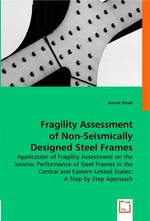The Central and Eastern United States (CEUS) is a region that is characterized by low frequency-high consequence seismic events such as the New Madrid sequence of 1811-1812. The majority of steel-framed buildings in the CEUS were designed without regard to seismic loads. Such frames possess limited seismic resistance, and may pose an unacceptable risk if a large earthquake were to occur in the region. The seismic fragility analyses in this study focus on steel frames that are typical of building construction in regions of infrequent seismicity; such frames have received little attention to date in building seismic risk assessment. Current steel building stock in Shelby Co., Tennessee has been represented by five code-compliant model frames with different lateral force-resisting systems, i.e., braced-frames, partially-restrained moment frames and a rigid moment frame. The seismic performance of these model frames under different hazard levels was assessed using fragility curves. Different rehabilitation methods were discussed and applied. Capacity Spectrum Method was investigated regarding its applicability to the model frames.
Данное издание не является оригинальным. Книга печатается по технологии принт-он-деманд после получения заказа.


